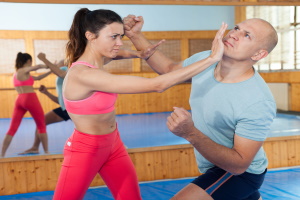How do you deal with street attacks?

I’ve noticed this same general feeling with many students in Kung Fu. The basic assumption is that their style of Kung Fu does not teach defense against street fights (basic jabs and hook-type punching), which stems from the misunderstanding of the protection philosophy. We teach self-defense against various attacks, including left and right punching techniques. These basic principles of self-defense against punches hold for all types of punching techniques.
However, the primary difference between the two attacks is that school practice involves an antagonist stepping forward and throwing a punch. In contrast, the street punch involves a close-quarter punch with the antagonist moving or dancing around rather than stepping forward and punching.
Fear of the unknown disrupts our mental and physical abilities when confronted with this type of street antagonist. A question enters my mind: What should I do? First, we must change our thinking process. Students of Kung Fu exhibit frustration caused by the inherent feeling that they have to fight the same way as the street antagonist. Wrong!
We train Kung Fu to heighten our awareness of defensive choices and improve our physical attributes. Why would we want to fight the same way as the street antagonist? We don’t train that way, so why fight that way? So, how do we defend against such attacks by merely doing what we know? Don’t fight like they do because they have already won if you do.

Second, let’s examine the choices available for these types of attacks. Kicks effectively increase the distance from the attacker. Various kicks give you more defensive options: Round kicks, Front kicks, Side kicks.
These kicks, kept from the waist down, help disrupt hand techniques by keeping us out of the attack’s reach.
What if the attacker uses kicks into the legs? The same theory would apply unless the attacker trained in Kung Fu; his effective range and knowledge of kicks are limited.
Kung Fu striking techniques also allow us an advantage, and they, too, will keep us effectively out of range of most street-type punches. The basic corkscrew punch travels a straight line and is faster than a hooking type of attack; it also works with full joint extension, while jabs or hooks never achieve a full extension. Try this yourself. Place a fully extended punch on someone’s chin, then have them throw a hook or jab punch. In most cases, their technique will not reach you unless they have extremely long arms or don’t throw the jab or hook properly.
If we examine the attacker’s posture, we can learn what he will do and decide on our attack plan before he precipitates his attack. Most attackers will stand with one leg slightly forward of the other, usually with the stronger side to the rear. So we immediately know which side is their stronger side and the one they will probably try to hit us with first. Pick your block for this attack and mentally prepare yourself for it. We are going to take care of this situation quickly. We are not going to duke it out.
If they attack, don’t back away. Move forward with your block and strike one of the mentioned areas. Most antagonists don’t expect this, which gives you the advantage of surprise and puts you in control of the situation. Now, you know what to do. Strike the groin, hit the throat, strike the eyes, but take care of the problem as quickly as possible. There is no such thing as a fair
fight.
Of course, you can strike the person before they even get set to attack. Why wait? Strike first, fast, and effectively. Walking or running away yields the best defensive choice; it saves you from harm and protects you from harming another person. Everyone wins.